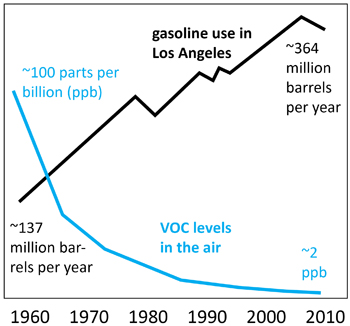A .gov website belongs to an official government organization in the United States.
A lock () or https:// means you've safely connected to the .gov website. Share sensitive information only on official, secure websites.
9 August 2012

Scientists find steady reduction in one type of air pollutant, although region still suffers bad air days.
In California's Los Angeles Basin, levels of some vehicle-related air pollutants have decreased by about 98 percent since the 1960s, even as area residents now burn three times as much gasoline and diesel fuel. Between 2002 and 2010 alone, the concentration of air pollutants called volatile organic compounds (VOCs) dropped by half, according to a new study by NOAA scientists and colleagues, "Multi-Year Trends in Volatile Organic Compounds in Los Angeles, California: Five Decades of Decreasing Emissions" published in the Journal of Geophysical Research yesterday.
"The reason is simple: Cars are getting cleaner," said Carsten Warneke, a NOAA-funded scientist with CIRES at the University of Colorado Boulder.
VOCs, primarily emitted from the tailpipes of vehicles, are a key ingredient in the formation of ground-level ozone which, at high levels, can harm people's lungs and damage crops and other plants.
The magnitude of the drop in VOC levels was surprising, even to researchers who expected some kind of decrease resulting from California's longtime efforts to control vehicle pollution.
"Even on the most polluted day during a research mission in 2010, we measured half the VOCs we had seen just eight years earlier," Warneke said. "The difference was amazing."
The 98 percent drop in VOCs in the last 50 years does not mean that ozone levels have dropped that steeply; the air chemistry that leads from VOCs to ozone is more complex than that. Ozone pollution in the Los Angeles Basin has decreased since the 1960s, but levels still don't meet ozone standards set by the Environmental Protection Agency.
Requirements for catalytic converters, use of reformulated fuels less prone to evaporate, and improved engine efficiency of new vehicles have all likely contributed to overall declines in vehicle-related pollution, including VOCs.
The improvement in this one measure of air quality in Los Angeles may not surprise many longtime residents, Warneke said. People who lived in the city in the 1960s often couldn't see nearby mountains through the smog; today, they often can.
For the new study, Warneke and his colleagues evaluated Los Angeles air quality measurements from three sources: NOAA-led research campaigns in 2002 and 2010, which involved extensive aircraft sampling of the atmosphere; datasets from other intensive field campaigns reaching back five decades; and air quality measurements from the California Air Resources Board monitoring sites, which reach back two to three decades.
Overall, VOCs dropped by an average of 7.5 percent per year. "This is essentially the kind of change we would expect, and it is very good to find that it is actually taking place," Warneke said.
A few specific VOCs, such as propane and ethane, did not drop as quickly. Those chemicals come from sources other than vehicles, such as the use and production of natural gas. Another recent study led by CIRES and NOAA researchers has shown that one VOC, ethanol, is increasing in the atmosphere, consistent with its increasing use in transportation fuels.
Warneke said that he would expect the decrease in emissions of VOCs by cars to continue in Los Angeles, given that engine efficiency continues to improve and older, more polluting vehicles drop out of the fleet of all vehicles on the road.
Warneke, C., J. A. de Gouw, J. S. S. Holloway, J. Peischl, T. B. B. Ryerson, E. L. Atlas, D. R. Blake, M. K. Trainer, and D. D. Parrish, Multi-year trends in volatile organic compounds in Los Angeles, California: Five decades of decreasing emissions, Journal of Geophysical Research, doi:10.1029/2012JD017899, 2012.
Airborne measurements of volatile organic compounds (VOCs) were performed during CalNex 2010 (California Research at the Nexus of Air Quality and Climate Change) in the Los Angeles (LA) basin in May-June 2010 and during ITCT2k2 (Intercontinental Transport and Chemical Transformation) in May 2002. While CO2 enhancements in the basin were similar between the two years, the ΔCO/ΔCO2 ratio had decreased by about a factor of two. The ΔVOC/ΔCO emission ratios stayed relatively constant between the two years. This indicates that, relative to CO2, VOCs in the LA basin also decreased by about a factor of two since 2002. These data are compared with the results from various previous field campaigns dating back as early as 1960 and from the extensive air quality monitoring system in the LA basin going back to 1980. The results show that the mixing ratios of VOCs and CO have decreased by almost two orders of magnitude during the past five decades at an average annual rate of about 7.5%. Exceptions to this trend are the small alkanes ethane and propane, which have decreased slower due to the use and production of natural gas. A comparison with trends in London, UK shows that, due to stricter regulations at the time, VOC mixing ratios in LA decreased earlier than in London, albeit at a slower rate, such that typical mixing ratios in both cities in 2008 were at about the same level.